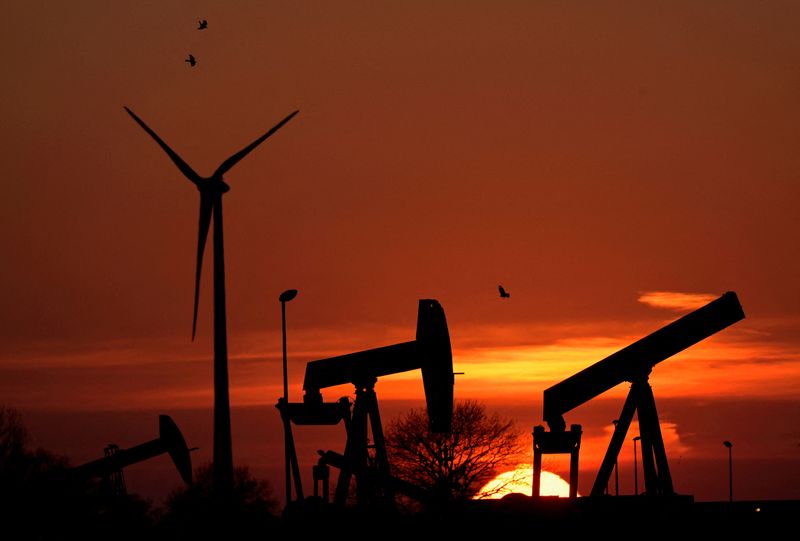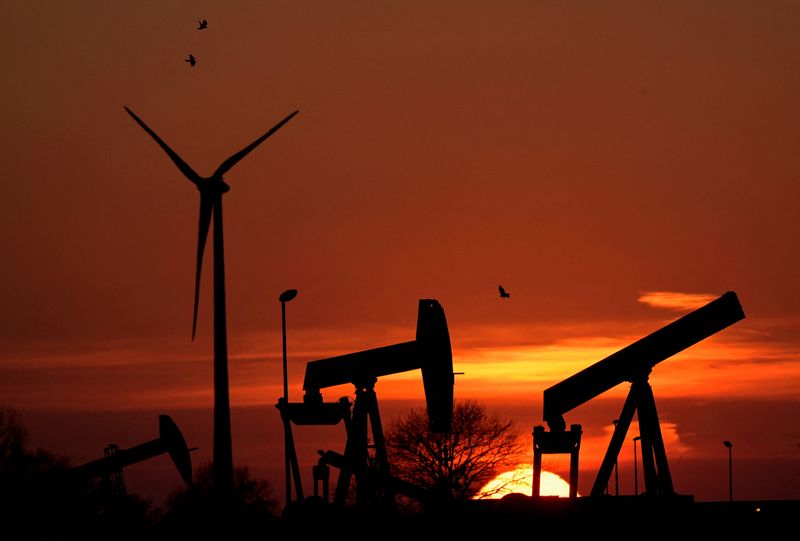Commodities
Oil prices settle up 3% on supply concerns after oilfield shutdown in Libya


© Reuters. FILE PHOTO: Pump jacks of Wintershall DEA are pictured in Emlichheim near the northern German city of Meppen, Germany, March 9, 2022. REUTERS/Fabian Bimmer/File Photo
By Scott DiSavino
NEW YORK (Reuters) – Oil prices climbed on Wednesday, settling up about 3% after a disruption at Libya’s top oilfield added to fears that mounting tensions in the Middle East could disrupt global oil supplies.
() futures rose $2.36, or 3.1%, to settle at $78.25 a barrel. U.S. West Texas Intermediate (WTI) crude rose $2.32, or 3.3%, to settle at $72.70.
Both crude benchmarks settled higher for the for the first time in five days with the biggest daily percentage gain for WTI since mid November.
“Oil is trading … higher today, buoyed it would appear by protests at Libya’s largest oilfield and further attacks in the Red Sea,” said Craig Erlam, senior market analyst UK & EMEA, at data and analytics firm OANDA.
In OPEC member Libya, protests forced a shutdown of production at the 300,000 barrel per day (bpd) Sharara oilfield.
Oil prices also climbed after Israel intensified its bombing of the Gaza Strip after its war with the Iran-backed Palestinian Hamas group stretched into Lebanon with the killing in Beirut of Hamas’ deputy leader. Israel has neither confirmed nor denied responsibility.
The head of Lebanon’s armed group Hezbollah, also backed by Iran, warned the killing of Hamas’ deputy chief was “a major, dangerous crime about which we cannot be silent”.
In the Red Sea, another Iran-backed group, the Houthis in Yemen, continued to attack vessels, prompting concerns that a wider Middle East conflict could develop and close crucial oil transport waterways like the Red Sea and Persian Gulf.
In OPEC member Iran, two explosions killed more than 100 people and wounded scores at a ceremony to commemorate top commander Qassem Soleimani who was killed by a U.S. drone in 2020.
The Organization of the Petroleum Exporting Countries (OPEC) said cooperation and dialogue within the wider OPEC+ oil producer alliance will continue after Angola last month announced it would leave the group.
OPEC+, which includes OPEC and allies like Russia, said it plans a Feb. 1 meeting to review implementation of its latest oil output cut.
FED AND OIL INVENTORIES
Federal Reserve officials appeared increasingly convinced inflation was coming under control, according to the minutes of U.S. central bank’s December meeting.
The Fed is widely expected to keep rates on hold in January. Traders have priced in a 65.7% chance of a 25 basis point rate cut in March, according to CMEGroup’s FedWatch tool.
Lower interest rates reduce consumer borrowing costs, which can boost economic growth and demand for oil.
The American Petroleum Institute (API), an industry group, and the U.S. Energy Information Administration will release their oil inventory reports one day later than usual due to the New Year holiday with API expected around 4:30 p.m. EST on Wednesday and EIA on Thursday.
Analysts forecast U.S. energy firms pulled about 3.7 million barrels of oil from storage during the week ended Dec. 29. [EIA/S] [EIA/A]
That compares with a build of 1.7 million barrels in the same week last year and a five-year (2018-2022) average decline of 4.0 million barrels.
Commodities
Oil prices rise; U.S. crude inventories plunge, Russia-Ukraine truce eyed
Commodities
India’s Reliance to stop buying Venezuelan oil over US tariffs, sources say
Commodities
Oil prices climb on Venezuela supply worries

 Forex3 years ago
Forex3 years agoForex Today: the dollar is gaining strength amid gloomy sentiment at the start of the Fed’s week

 Forex3 years ago
Forex3 years agoUnbiased review of Pocket Option broker

 Forex3 years ago
Forex3 years agoDollar to pound sterling exchange rate today: Pound plummeted to its lowest since 1985

 Forex3 years ago
Forex3 years agoHow is the Australian dollar doing today?

 Cryptocurrency3 years ago
Cryptocurrency3 years agoWhat happened in the crypto market – current events today

 World3 years ago
World3 years agoWhy are modern video games an art form?

 Commodities3 years ago
Commodities3 years agoCopper continues to fall in price on expectations of lower demand in China

 Economy3 years ago
Economy3 years agoCrude oil tankers double in price due to EU anti-Russian sanctions























